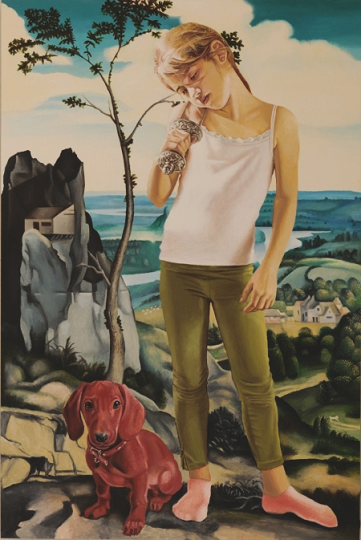Last week I wrote an article about Inglewood Open Studios, an annual weekend celebration of the working artists in that community, and one such artist that caught my eye was Jesus Max. Born in the Cantabria region of northern Spain, he spent most of his childhood and adolescence in the province of Burgos, in a wine-producing town called Aranda de Duero. The town is highly recognized for its underground interconnected wine cellars and caves that have been in place since the 12th century and holds yearly celebrations to honor the local patron saint, The Lady of the Vines. Jesus Max was fourteen years old when the Generalissimo Francisco Franco died, military leader of Spain for almost forty years, and witnessed the change from dictatorship to democracy overnight, with civil unrest like national strikes and a failed attempted coup by pro-Francoists in the immediate aftermath. Political chaos ran rampant across the country, but Jesus was busy painting and studying ceramics in the capital of Madrid.
A few years later he was contacted by an emerging art collective in his hometown of Aranda de Duero and was asked to participate in the advancement of a local art movement. Their art studio was in an industrial warehouse near the Duero River that runs all the way to Portugal, and it played a significant role in their identity that led to the name, A UA Crag, which Agua is water in Spanish, but they removed the G and added it to the second word as onomatopoeia to directly suggest the source of the sound. Inspired by German Expressionism and Italian Transavantgarde, the collective was made up of mostly painters and sculptors who would work on conceptual projects for two-week periods across other major European cities in France, England, Belgium, Holland, and Germany. After ten years of doing this type of work and living that fluctuating lifestyle, he yearned for something more peaceful and permanent. His wife suggested Los Angeles, California.
When Jesus Max made the transition to move out West, he was already thirty-seven, he didn't speak English, and he didn't drive or have a driver's license, but he was determined to learn and grow from isolation, introversion, the ecology of his surroundings, and a less chaotic environment where a more peaceful, mystical, and spiritual approach would be preferable for his work. Living and working in Los Angeles, his work now maintains a more symbolic content and a return to historical and mythological narratives. In his opinion, a lot of contemporary art has shifted from an emphasis placed on people in preference for external conditions, which in many ways has disconnected us from the human condition, emotion, and the inner-depth associated with relating to art. His main objective is for his work to be observed for long periods of time where the viewer can extrapolate different perspectives and opinions that evoke substance and profoundness. His work is bold and challenging and you can catch some of it at 1019 west in Inglewood, local museums in the South Bay, and a forthcoming exhibit in MUSAC, The Museo de Arte Contemporáneo de Castilla y León, which will focus on the A UA Crag collective, its influence, and the historical content of some of their previous work done in the south of France.
